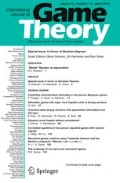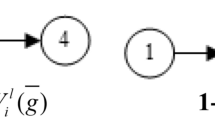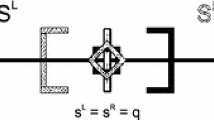Abstract
We model the formation of collaboration networks among firms that are located in a circular city as a two-stage game. In the first stage, the firms form collaboration links, and in the second stage, they engage in price competition. If two firms form a link, their production costs in the second stage are reduced. The second stage is a generalization of Salop’s (Bell J Econ 10(1):141–156, 1979) circular city model. We provide a complete characterization of equilibrium prices of the model. We show that a firm prefers forming a link with a more distant firm if the cost-reducing effects are the same. We discuss the stability and social efficiency of the collaboration networks. When link costs are small, there is no conflict between efficiency and stability of networks. When link costs are significant, there is a conflict between efficiency and stability of networks. We also examine the average distances between linked firms.
Similar content being viewed by others
References
Berge C (1976) Graphs and hypergraphs, 2nd rev. edn. (English translation by Minieka E). Elsevier, North-Holland
Bloch F (2005) Group and network formation in industrial organization: a survey. In: Demange G, Wooders M (eds) Group formation in economics; networks, clubs and coalitions. Cambridge University Press, Cambridge, pp 335–353
Economides N (1993) Quality variations in the circular model of variety-differentiated products. Reg Sci Urban Econ 23: 235–257
Goyal S, Joshi S (2003) Network of collaboration in oligopoly. Games Econ Behav 43: 57–85
Goyal S, Joshi S (2006) Unequal connections. Int J Game Theory 34: 319–349
Jackson M, Rogers B (2005) The economics of small worlds. J Eur Econ Assoc 3(2–3): 617–627
Jackson M, Watts A (2002) The evolution of social economic networks. J Econ Theory 106: 265–295
Jackson M, Wolinsky A (1996) A strategic model of economic and social network. J Econ Theory 71: 44–74
Johnson C, Gilles RP (2000) Spatial social networks. Rev Econ Des 5: 273–300
Kawamata K (2004) Cournot oligopoly with network formation (in Japanese). Mita Gakkai Zasshi 96: 633–648
Okumura Y (2007) A network formation process converges to the complete collaboration network. Math Soc Sci 53(2): 134–139
Salop SC (1979) Monopolistic competition with outside goods. Bell J Econ 10(1): 141–156
Song H, Vannetelbosch VJ (2007) International R&D collaboration networks. Manch Sch 75(6): 742–766
Author information
Authors and Affiliations
Corresponding author
Rights and permissions
About this article
Cite this article
Okumura, Y. Spatial competition and collaboration networks. Int J Game Theory 41, 455–472 (2012). https://doi.org/10.1007/s00182-011-0297-3
Accepted:
Published:
Issue Date:
DOI: https://doi.org/10.1007/s00182-011-0297-3




